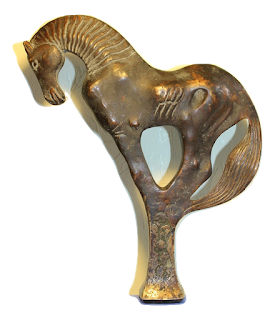Heavenly Horses

In nomadic tradition, horse is one of the mythological animals, embodying the connection with the other world, with the supernatural. The horse, exceptionally white, has always been associated with the sun, with daytime clarity, with fire, air, sky, water, solar heroes, as an expression of good human aspirations in his daily work and struggle against difficulties. The white sun horse is an attribute of divine forces constantly fighting against evil, an opposition to death. In the beliefs and rites of nomads, firstly, the horse itself, secondly, its separate parts — the skull, cervical vertebrae, skin, hair, thirdly, objects associated with it — bridle, clamp, sweat, reins, whip, fallen horseshoe, image, etc. act as the patroness and protector of people. The horse had the ability to drive out evil forces from the human body. A vivid evidence of such a cult is an artifact found in the early twentieth century in the North part of China, which was finished in the form of a horse. Dating of...
